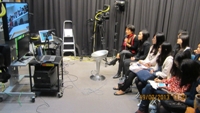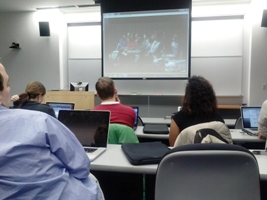

We hit it off. Ava and I were both full-time faculty pursuing our PhDs, and before moving into academia we had long careers in the newsroom. We discussed ways that we could collaborate across time zones.
The conversation had a familiar ring. Finding ways to connect via continents had become second nature to me. Since relocating to Hong Kong in 2010, social media helped me keep in touch with family and friends overseas. To be sure, I had reaped the benefits of staying connected Facebook, Twitter, and Skype, but never imagined that such tools could also transform learning and teaching.
If new technologies could keep friendships thriving from afar, who was to say it couldn’t work its same magic in the classroom?
Taking the Plunge
In the fall Ava and I wove in the Skype exchange in our existing course outlines to find a crossroad.
In many ways my course Mobile Journalism – launched in Fall 2012 -- was still in its infancy. Students shoot stories and edit them via the smartphone. Ava’s class was a traditional broadcast class, but we agreed that the students could learn a lot by sharing about these different news gathering platforms.
Of course in any new adventure, there is the wild card. Technology was the bridge in this experiment, but also the element of uncertainty. I tapped Howson Tsang the head of our broadcast studio, and a tech-savvy student Raymond for the technical team. We set “Skype test” dates before the start of the new semester. The connection was crisp and clear, not a crackle or blip in 45 minutes. Now fingers crossed for the start of the semester.
Compromise Across Time Zones
My students, all of them natives of Hong Kong, were still at sphinxes when I told them about the special exchange.
“We have a very special exchange via Skype with the students at Northwestern…” I said. I was disconcerted with their blank stares. Did they understand what I was saying? I repeated myself again. “We have a very special exchange via Skype with the students at Northwestern…” I saw a smile or two when I told them that these students were also journalism majors. I found myself explaining at length about the time zone differences saying, “9am here is 7pm there or 10am here is 8pm there,” I found myself repeating like a mantra.
Time zone differences became a major part of the experiment.
Given our 14-hour difference successful exchange was only possible with give and take from professors and students.
Ava’s class agreed to stay an extra hour from 8-9pm while my class would come in an hour earlier at 9am rather than 10am.
At the end of the class some students Googled Northwestern, Medill and Chicago and diversity in America. A good sign. An open-mind and curiosity were essential elements of success.
Culture Shock
Our first session was in the broadcast studio. All 21 students arrived on time. The technical team had set everything up the day before. It was a favorable Skype day. We could see Ava’s class clearly and vice versa. The challenge at the start was finding a format for the discussions. I quickly discovered that it worked best when Ava and I ignited the discussions with questions.
Once the students became more familiar with the format of the class – passing the microphone to each other to share -- the discussions were eye-opening.
One of the first discussions was about “diversity” in the context of news coverage and the newsroom. This concept of diversity was foreign to the students and to the media environment in Hong Kong. My students tended to view diversity, especially ethnic diversity, more in the context of Hong Kongers vs. Mainlanders. Still while our definitions of diversity differed, the students were able to take that topic and exchange information about culture, journalism and the media environment in their respected countries.
As part of our exchange we had the students swap projects and critique each other. The students swiftly posted their stories online via YouTube or Vimeo for the critique.
By the look of their expressions and the vibe of the class, I noticed how attentive my students were when receiving feedback from the Medill students. A few proactively amended their projects per the feedback.
“I think the critique part is very useful for both of students in the Northwestern and Shue Yan because we can receive comprehensive feedback from both teachers and audience overseas. Not only did the participants give comments on the video projects, but they also provide useful and practicable technical suggestions,” a student wrote.
Over the course of our three Skype sessions, I saw my students become more interactive. The blank stares had disappeared. A few of the students told me that the liveliness and openness of the American students was infectious and encouraged them to also speak up.
They now knew many of the Medill students by name. They commented at how diverse the class was, and how classes in the U.S. seemed more lively and interactive. It left me wondering if distance – just enough because of the TV screen in between and the fragile yet incredibly powerful Internet connection – gave them the confidence to be themselves. I thought about teenagers who chat freely on IM or hide behind an avatar on Facebook. Maybe Skype in some ways provided a safe haven.
Given that our University doesn’t have study abroad programs, numerous students told me that it was the closest thing to such a program they would have. I saw a common theme in their feedback. They wanted more exchanges. They wanted the Medill students to visit. They wanted to visit the U.S.
One student wrote: “As we all know technology is definitely our future…this will be one of the most unforgettable experiences in my school career. Before that, I seldom used Skype as a tool to chat with others, it is not even installed in my computer, but now I will try to install it and tell others it is a good tool for communication.”
In keeping with the social media spirit, we launched a Facebook group and invited the Medill students to join. I secretly hoped that it would be a way for the students to stay in touch long after Skype ended.
Upon reflection the exchange taught me that my role was not simply as educator, but as a facilitator. It was in asking questions, in igniting thought and curiosity, ultimately in the hopes that the students would motivate each other to learn. The experiment proved that learning could thrive outside of the traditional routes of tests, and proof that the combination of using the latest technologies, in asking questions, in combining culture, syncing time zones, in sharing about media and journalism differences and similarities, and most importantly keeping an open mind, we had finally arrived at a crossroad. Technology was not only a connection and bridge, but played a role in creating the communication and conversation we shared. The experiment had worked.
In fact, the greatest value seemed to be in the discovery of technology and each other. There were no limits.
“This kind of cultural exchange isn’t many people that can think of. Thanks to the technology, Carrying out this kind of exchange requires no more airplanes, nor any leased lines. An ordinary computer, ordinary camera, and a simple Internet connection do the job,” a student reflected.
And the feedback was unanimous, the possibilities certainly now endless.
“I want to do this again,” a student told me after we disconnected the Skype on the last day of the session. “I do too,” I thought replying with a nod and smile. It was a good start.
* * * *
A chance meeting with Professor Amy Wu of Hong Kong Shue Yan University at the Unity Journalists Convention in the summer of 2012 turned out to be a chance for exploration. Over the course of several months we talked and tested our plan to have our respective journalism classes participate in three, one-hour-long exchanges via SKYPE during the first quarter of 2013.
To succeed, our students would need to learn something about each other and something about themselves. We chose video reporting on diversity issues as a lens through which to understand each other’s culture. We accomplished that and more.
When asked to provide their final thoughts about the experiment one student wrote: “I learned how the definition of diversity is different everywhere. We have a definition and frame here in the United States, but it’s completely different in Hong Kong,”
In the end, my students produced better final reporting projects than past groups and I think our collaboration was a major factor. Dissecting diversity reporting in their respective countries forced students to examine the assumptions they held about an audience’s background knowledge. My students and I and came face to face with the reality that we really did not know much about Hong Kong. We were lacking historical and local context. However, Prof. Wu and her students helped us make meaning.
The two groups critiqued each other’s video stories, providing both positive and critical feedback. There’s something about knowing your work will be assessed by someone other than your professor. The need to be understood and provide context takes on a sense of urgency when the reviewer does not live in your country or share your culture.
“The most important lesson was not to assume anything,” another student wrote. “Specifically with the Hong Kong collaboration we talked about the distinguishing factors between the Mainland and Hong Kong. It’s easy to generalize, but I’m called to report.”
I believe that extra effort spilled over into my students’ final projects. I recorded higher grades among more students that quarter than I had during nearly two decades of teaching. Of course, I cannot absolutely attribute the improvement to this exchange. But it’s worth exploring and repeating.
A collaboration like this requires some give and take. Because of the time difference of 14 hours, it was easier for my students to move our class time to the evenings during our Skype sessions. When it was their Tuesday 10 am class time in Hong Kong, it was Monday 8 pm in Evanston, Illinois. Furthermore, we had to factor in our quarter system with their semester system and their Chinese New Year break when we selected dates to collaborate.
We were worried about the reliability of the Skype, but it rarely failed. And when it did, it was usually operator error on my part. Though a project such as this one requires extra work, the payoff is worth it for the students and faculty. We are already thinking about how to improve future collaborations.
The farther away from home base, the more likely students will be engaged. But for instructors who are not ready to venture beyond their home country, collaborating with classes in a different region or even a different part of their metropolitan area is an option. Pushing students beyond their comfort level is always the goal. Now that the technology is accessible, we can easily push beyond our borders, too.


